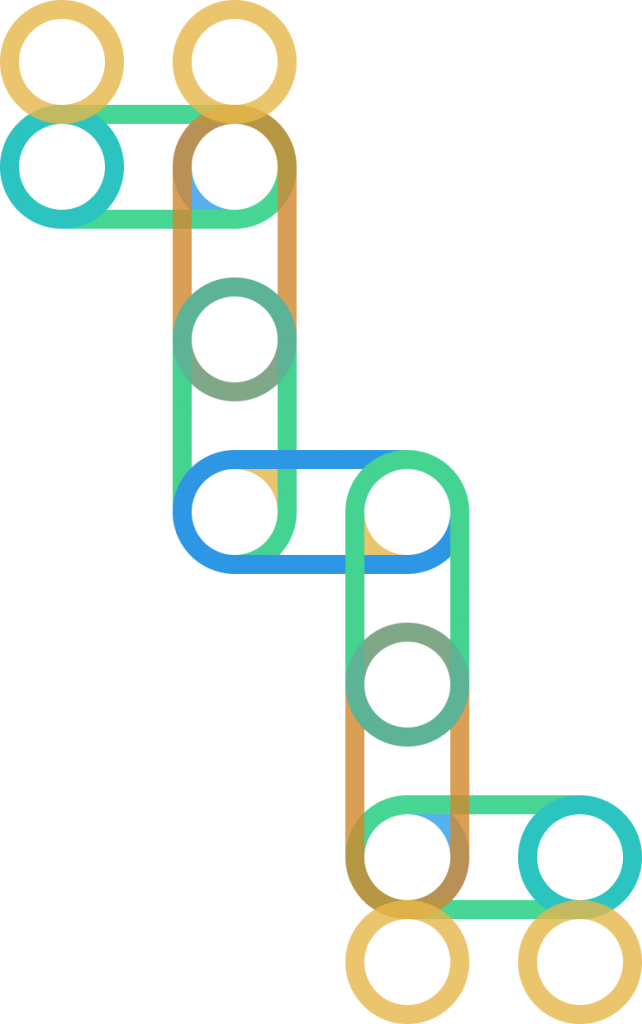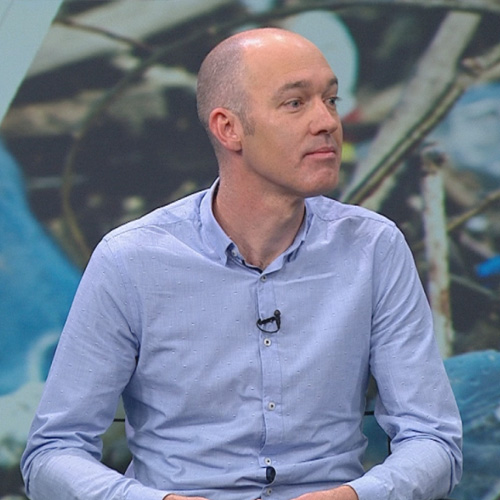
Pioneering scientists and entrepreneurs are forging a regenerative path for PET plastic through nature-inspired biotechnology, waste collector empowerment, thoughtful design, innovative financing, and effective policies that together transform waste into valuable resources.

In the face of mounting plastic pollution, the quest for a regenerative path for PET plastic requires innovative thinking that draws from multiple disciplines, perspectives, and approaches.
Through conversations with three pioneering figures in the field—Dr. Federica Bertocchini, who discovered plastic-degrading enzymes in waxworms; Dr. Jo Sadler, whose lab is transforming PET waste into valuable compounds like vanillin; and Thierry Sanders, whose Kolekt app is empowering waste collectors across the globe—a comprehensive roadmap emerges.
Their collective insights reveal that creating a regenerative pathway for PET isn’t just about technological innovation; it requires simultaneously addressing systemic challenges in financing, policy, and social equity. Here are five actionable steps to forge this regenerative path.
1. Invest in nature-inspired biotechnology
Nature has been solving complex problems for billions of years. As Dr. Federica Bertocchini discovered when waxworms created holes in her plastic bags, sometimes the most innovative solutions come from careful observation of the natural world.
“In more holistic terms, may say, observing nature always gives you some answers that you won’t expect,” explains Dr. Bertocchini. “Something the idea of having the worm that might give you a solution. I mean, an animal in nature that might give you a solution. So that’s what we learned.”
While Dr. Bertocchini’s work focuses on polyethylene, the principle applies equally to PET. Dr. Jo Sadler’s research at the University of Edinburgh exemplifies this approach, using bacteria to transform PET waste into high-value molecules like vanillin—the compound that gives vanilla its characteristic flavor.
“What we’re trying to do is develop an alternative route, which is from waste PET,” Dr. Sadler explains. “We can depolymerize that PET down into its monomers. And then we’ve developed bacterial strains, which cherry picking tools from nature, have combined enzymes and new functionality which can take the terephthalic acid, which is one of the degradation products of PET, and convert that, we call upcycling, into vanilla.”
Actionable Implementation:
- Scale up funding for research into biocatalytic processes specifically for PET degradation and transformation
- Create collaborative platforms where researchers can share discoveries about enzymatic processes
- Develop industrial partnerships to bridge the gap between laboratory success and commercial application
- Explore combined approaches that leverage both biological and chemical processes
Dr. Sadler emphasises the importance of these partnerships: “I’m quite keen to match that with new technologies, which will treat these next-gen plastics also as a feedstock and think about everything, even things that we haven’t yet developed, but think about them as part of a circular life cycle right from the outset.”
2. Recognise and empower waste collectors
While sophisticated enzymatic technologies offer promising long-term solutions, we must simultaneously address the immediate challenges of plastic collection. Thierry Sanders, founder of Kolekt, highlights the critical role of the world’s 20 million waste collectors who handle approximately 60% of globally recycled materials.
“They are basically the most efficient form of waste collection that we have, assorted waste collection,” Sanders explains. Despite this essential contribution, these workers typically earn only about 60% of minimum wage and face significant health and safety risks.
Sanders developed the Kolekt app to address these challenges, creating a digital platform that allows waste collectors to find recyclable materials more efficiently and receive fair compensation directly. The app also provides transparency throughout the recycling chain, helping recyclers verify the provenance of their materials.
“By using Collect, they can still sort of rig the system and keep some money in their pocket, but it’s very difficult for them to cheat consistently,” Sanders explains, describing how the app has reduced corruption and ensured fairer payments to waste collectors.
Actionable Implementation:
- Support digital platforms that connect waste collectors directly with recyclers and brands
- Implement premium payment systems where producers subsidize the collection of their materials
- Include waste collectors in Extended Producer Responsibility (EPR) schemes while respecting their preference for informality
- Develop health insurance and savings mechanisms specifically designed for waste collectors
Sanders emphasises that waste collectors “want recognition for the wonderful work they do,” not necessarily formalisation that might subject them to taxes they can’t afford to pay.
3. Redesign PET products with end-of-life in mind
Creating a regenerative path for PET requires thinking about end-of-life at the beginning of design. This means moving beyond incremental improvements toward fundamentally reimagined products.
Dr. Sadler describes this approach: “I’m quite keen to match that with new technologies, which will treat these next-gen plastics also as a feedstock and think about everything, even things that we haven’t yet developed, but think about them as part of a circular life cycle right from the outset so that we don’t just do a kind of pollution swap in the future.”
This perspective aligns with Dr. Bertocchini’s observation that “it starts with thinking about what is the end of life for this material and then kind of working back from there.” Such thinking encompasses not just recycling but considers multiple pathways for materials, including biodegradation, chemical recycling, and biotransformation.
Sanders adds another dimension to this discussion, noting that poor design choices can make recycling economically unfeasible: “If you look at Coca-Cola 500 milliliter Coca-Cola bottle, you know, the EPR fee on that bottle will be less than one, less than 10% of one US dollar cent.” However, multi-layered packaging often has no viable recycling pathway, requiring either design changes or significant financial incentives for collection.
Actionable Implementation:
- Standardise PET colors and additives to improve recyclability
- Implement higher EPR fees for difficult-to-recycle designs to incentivize better design
- Develop product passport systems that track the complete lifecycle of PET products
- Create collaborative design platforms where scientists, engineers, and waste management experts can inform product development
As Dr. Sadler notes, “If you’re developing a new food packaging product, is it mixed plastics? Because that’s really difficult. That’s really challenging to recycle. Or can it be streamlined into a single plastic type or two plastics types or a plastic and paper, [that] is more easily recyclable?”
4. Create financial systems that value regeneration
A regenerative path for PET requires financial systems that recognise and reward environmental and social value—not just short-term financial returns.
Dr. Bertocchini highlights how current financial structures impede innovation: “Can you go cheaper than burning? That’s what I was asked.” This perspective fails to account for the full spectrum of costs and benefits associated with different approaches to plastic waste.
Thierry Sanders describes a more promising model through his work with the Bali Investment Club, where they focus on three criteria: “Is it going to help the climate? Is it going to reduce the waste problem? And is it going to raise the income for the poor?” Rather than maximising financial returns, they establish minimum financial thresholds while prioritising these broader impacts.
Sanders also emphasises the potential for more localised financial systems: “We should also look among each other to see if we can set up new vehicles which work for us and not for them. So for example, collectives or cooperatives are very well equipped and have the right legislation for, let’s say, waste picker cooperatives can save some of their money into a pool from which they can borrow.”
Actionable Implementation:
- Develop impact investment funds specifically focused on regenerative approaches to plastic
- Create blended finance mechanisms that combine public, philanthropic, and private capital
- Establish savings and credit cooperatives for waste collectors and recyclers
- Implement plastic credits systems that financially reward plastic recovery and recycling
As Sanders notes, “We shouldn’t be always looking for the solution from the pension funds and the Vanguards and BlackRocks. We should also look among each other to see if we can set up new vehicles which work for us.”
5. Implement effective policy frameworks
Creating a regenerative path for PET requires policy frameworks that align economic incentives with environmental and social goals. All three experts emphasise the importance of well-designed regulations in driving systemic change.
Sanders highlights Extended Producer Responsibility (EPR) as a particularly promising approach: “The 150 countries that don’t have an EPR scheme, which is mainly developing countries. Their governments should realize that they are missing out on roughly $5 per inhabitant per year.”
Dr. Sadler notes the importance of policy in driving innovation: “It’s attracted a lot of attention recently and there’ve been a number of notable calls and funding schemes recently which have really focused on this field, which is fantastic.”
Meanwhile, Dr. Bertocchini emphasizes that policy should support long-term innovation rather than expecting immediate solutions: “If you talk with industry, any kind of industry, generally speaking, they want a solution in six months. They want a solution in a way that you close the cycle.”
Actionable implementation:
- Establish ambitious EPR schemes with fees that reflect the true cost of material recovery
- Implement higher fees for difficult-to-recycle materials to incentivise better design
- Create independent oversight mechanisms to ensure EPR funds reach waste collectors
- Develop international standards for PET design and recycling
Sanders emphasises that governments shouldn’t delay implementation through endless consultation: “I think governments shouldn’t be organizing EPR regulations by going into long-winded dialogues with multinationals. They should be much more, let’s say, dictatorial about how it’s done and speed up the process.”
Building a regenerative future for PET
The path toward a regenerative future for PET isn’t about choosing between technological innovation, social equity, or policy reform—it requires integrating all these approaches. As Dr. Bertocchini notes, “It’s a holistic approach. All of us. Different parts of society, different involvement.”
Dr. Sadler reinforces this perspective: “There are so many opportunities out there to do innovative science and to kind of reintegrate this carbon back into the economy. But we just need to talk to each other more and give that science the opportunity to really take hold.”
This holistic vision recognises that creating a regenerative path for PET plastic requires transforming our relationship with materials at multiple levels—from molecular engineering to global finance. By investing in nature-inspired biotechnology, empowering waste collectors, redesigning products, creating regenerative financial systems, and implementing effective policies, we can transform PET from an environmental liability into a model of circular, regenerative material use.
The perspectives of Bertocchini, Sadler, and Sanders offer a compelling roadmap for this transformation—one that acknowledges complexity while providing clear, actionable steps toward a more regenerative future.
LOOKING FOR MORE INSPIRATION?
The future of plastics is being redefined, and you can be a part of it.
Your support can usher in a new era where plastic, once the problem, becomes an integral part of the solution. Sign up to play your part today.
Share it
Useful Links
THE HISTORY OF PLASTIC
Throughout the history of plastic, PET has been crucial in keeping food fresh with lightweight and durable packaging solutions that have helped reduce food waste for almost a century. Learn all about the invention of plastic and the important role it has played feeding people and saving the lives of humans and elephants in the adaPETation® timeline of the history of plastic.





